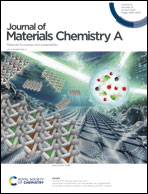Single-step synthesis of titanium nitride-oxide composite and AI-driven aging forecast for lithium–sulfur batteries†
Abstract
In this study, the polysulfide shuttle effect, a major impediment to the efficiency of lithium–sulfur (Li–S) batteries, is addressed. A titanium nitride-oxide (TiO2–TiN) composite is synthesized via a single-step liquid-phase reaction at 60 °C only, significantly streamlining the production for large-scale applications. This composite, serving as a cathode material in Li–S batteries, demonstrates remarkable performance, with an initial capacity of 774 mA h g−1, and maintains 517 mA h g−1 after 500 cycles at a 0.5C rate with a decay rate of 0.066% per cycle. The integration of a Super P carbon-coated separator further enhances the battery performance, achieving an initial capacity of 926 mA h g−1 and maintaining 628 mA h g−1 after 500 cycles, with the lower decay rate of 0.064% per cycle. Moreover, the integration of Long Short-Term Memory (LSTM) networks into data analysis has facilitated the creation of a deep learning-based predictive model. This model is adept at accurately forecasting the aging effects of batteries up to 100 cycles in advance. This AI-driven approach represents a novel paradigm in battery research, offering the potential to expedite the battery testing process and streamline quality control procedures. Such advancements are pivotal in making the commercialization of Li–S batteries more feasible and efficient.



 Please wait while we load your content...
Please wait while we load your content...